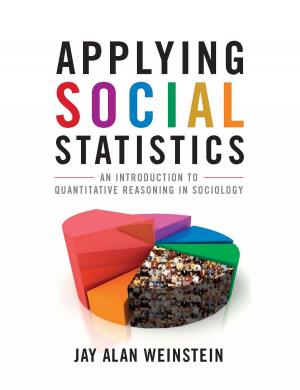Demography
The Science of Population
Nonfiction, Social & Cultural Studies, Social Science, Demography, Human Geography| Author: | Jay Weinstein, Vijayan K. Pillai | ISBN: | 9781442235212 |
| Publisher: | Rowman & Littlefield Publishers | Publication: | October 29, 2015 |
| Imprint: | Rowman & Littlefield Publishers | Language: | English |
| Author: | Jay Weinstein, Vijayan K. Pillai |
| ISBN: | 9781442235212 |
| Publisher: | Rowman & Littlefield Publishers |
| Publication: | October 29, 2015 |
| Imprint: | Rowman & Littlefield Publishers |
| Language: | English |
This comprehensive, introductory text takes an applied, interdisciplinary approach. Because one author is a sociologist and the other a demographer, the text introduces perspectives from many different disciplines. The most applied book on the market, Demography: The Science of Population teaches students how to use the multitude of demographic resources available to them as consumers of data. Using case studies throughout to illustrate key concepts in a realistic and concrete manner, the authors also draw examples from recent U.S. Census data, United Nations and World Bank reports, tables from the National Center for Health Statistics, and other U.S. state- and county-level sources.
New to the Second Edition
This second edition is divided into four main parts; each part begins with a short introduction, and all chapters include end-of-chapter summaries. All tables, related narrative, and graphics have been updated to include data from the 2000 and 2010 census counts, more recent estimates for the United States—especially the American Community Survey—and comparable new data from international sources (e.g. World Bank, Population Research Bureau World Data Sheet). Several new figures have been added throughout the text.
Part I: An Overview of Population Science, introduces the field of demography and provides a summary of its subject matter. The chapters in this part have been reorganized to reflect changes in the discipline.
- Chapter 1 now includes a new “the study of populations” section, a shorter Chapter 2 covers population size, and its former discussion of structure has been moved to Chapter 3. This de-emphasizes the history of population science to some extent and increases emphasis on population size as the key demographic variable.
- Chapter 4 presents the main principles and analytical techniques associated with the three “static” characteristics of populations: size, structure, and geographic distribution.
Part II: Population Dynamics: Vital Events and Growth, reflects the wealth of data and analytical techniques now available from The U.S. Centers for Disease Control and Prevention (CDC) and its “Wonder” utility. The first three chapters focus on the vital events of birth, death, and migration. The final chapter in this part brings this material together in a discussion of population growth: its measurement, its history, and current related policy concerns.
Part III: Population Models, introduces the principles of life table analysis, population estimation, and projection. This material has been simplified and updated. Chapter 9, The Life Table: An Introduction, has been revised to accord with the new federal alignment for vital statistics between the CDC and National Institute for Health Statistics. Life tables from non-U.S. sources are increased in number and in detailed functions.
Part IV: Demography in Application, provides overviews of population policy, the environment, and demographic resources, along with a brief postscript on population in the larger scheme of things. What appeared as two appendices in the first edition, one on the history of population policy and one on tourism as a type of international migration, have been combined to create a new Chapter 14.
The end-of-chapter material has been shortened and now contains a summary, key terms, and notes.
A full-color enhanced eText is also available, and the second edition is accompanied by a teaching and learning package, including instructor’s manual, test bank, lecture slides, and a companion website that offers students additional resources, flashcards, and self-study quizzes.
This comprehensive, introductory text takes an applied, interdisciplinary approach. Because one author is a sociologist and the other a demographer, the text introduces perspectives from many different disciplines. The most applied book on the market, Demography: The Science of Population teaches students how to use the multitude of demographic resources available to them as consumers of data. Using case studies throughout to illustrate key concepts in a realistic and concrete manner, the authors also draw examples from recent U.S. Census data, United Nations and World Bank reports, tables from the National Center for Health Statistics, and other U.S. state- and county-level sources.
New to the Second Edition
This second edition is divided into four main parts; each part begins with a short introduction, and all chapters include end-of-chapter summaries. All tables, related narrative, and graphics have been updated to include data from the 2000 and 2010 census counts, more recent estimates for the United States—especially the American Community Survey—and comparable new data from international sources (e.g. World Bank, Population Research Bureau World Data Sheet). Several new figures have been added throughout the text.
Part I: An Overview of Population Science, introduces the field of demography and provides a summary of its subject matter. The chapters in this part have been reorganized to reflect changes in the discipline.
- Chapter 1 now includes a new “the study of populations” section, a shorter Chapter 2 covers population size, and its former discussion of structure has been moved to Chapter 3. This de-emphasizes the history of population science to some extent and increases emphasis on population size as the key demographic variable.
- Chapter 4 presents the main principles and analytical techniques associated with the three “static” characteristics of populations: size, structure, and geographic distribution.
Part II: Population Dynamics: Vital Events and Growth, reflects the wealth of data and analytical techniques now available from The U.S. Centers for Disease Control and Prevention (CDC) and its “Wonder” utility. The first three chapters focus on the vital events of birth, death, and migration. The final chapter in this part brings this material together in a discussion of population growth: its measurement, its history, and current related policy concerns.
Part III: Population Models, introduces the principles of life table analysis, population estimation, and projection. This material has been simplified and updated. Chapter 9, The Life Table: An Introduction, has been revised to accord with the new federal alignment for vital statistics between the CDC and National Institute for Health Statistics. Life tables from non-U.S. sources are increased in number and in detailed functions.
Part IV: Demography in Application, provides overviews of population policy, the environment, and demographic resources, along with a brief postscript on population in the larger scheme of things. What appeared as two appendices in the first edition, one on the history of population policy and one on tourism as a type of international migration, have been combined to create a new Chapter 14.
The end-of-chapter material has been shortened and now contains a summary, key terms, and notes.
A full-color enhanced eText is also available, and the second edition is accompanied by a teaching and learning package, including instructor’s manual, test bank, lecture slides, and a companion website that offers students additional resources, flashcards, and self-study quizzes.















